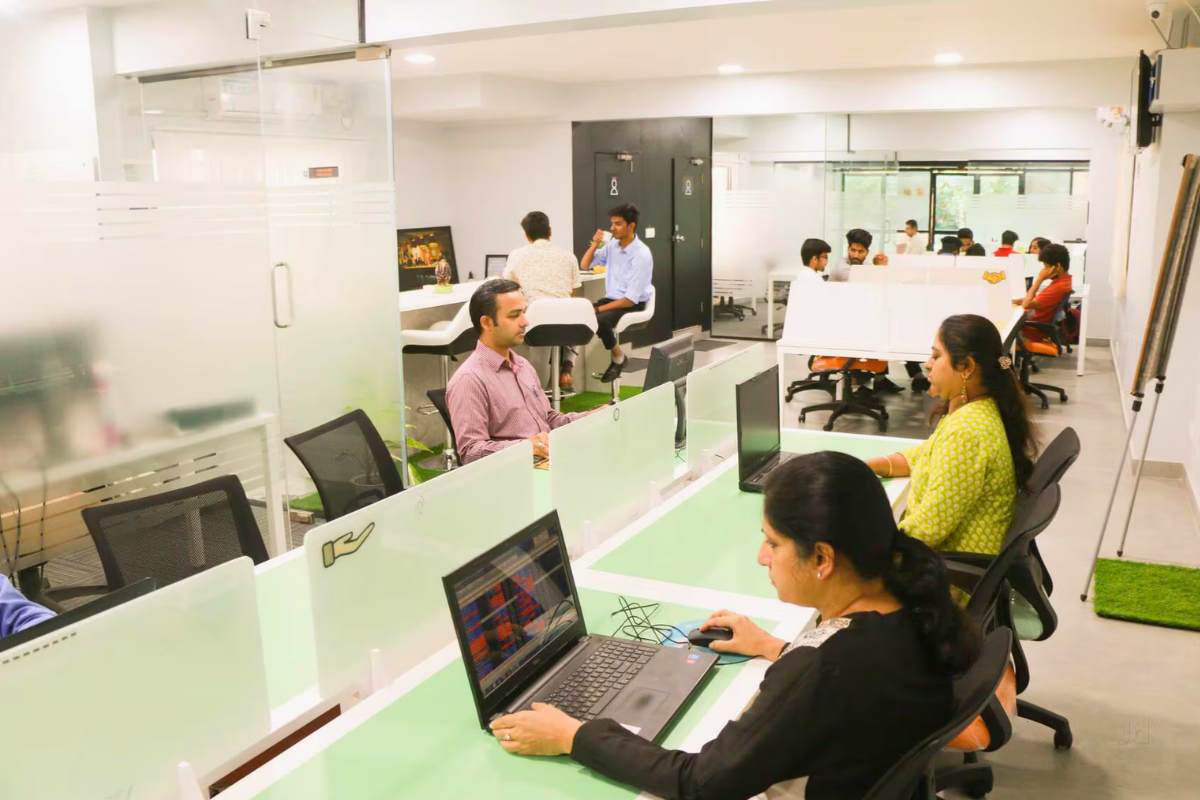When Salaries Stall and Rents Rocket, Modest Salary Growth in a Booming Sector.
In the Indian startup and IT industry, yearly salary increases tend to range between 8% and 15%. Although this increase sounds healthy on paper, particularly when compared to national average income increases, its effect in the real world is muted by the concurrent rise in living costs. Freshers in software development, cloud architecture, and data science may still earn premium salaries compared to other geographies, but mid‐career individuals see their purchasing power diminishing year after year.
- Software Engineers: A mid-level engineer who had earned ₹1,000,000 annually in 2020 may now be earning ₹1,075,000 after successive increments averaging 7.5% per annum, but this increase is eclipsed by rent hikes.
- Healthcare Specialists: Medical technologists, nurses, and even young doctors frequently have salary increases ranging from 5–8% per annum, but their housing expenses have increased by more than 20% per annum in sought-after residential enclaves.
Explosive Rent Inflation in Prime Localities
Since 2020, rents in Bengaluru’s desired neighborhoods have increased by 20–25% annually, nearly twice the rate of pay. Neighborhoods like Whitefield, Koramangala, HSR Layout, and Indiranagar have been the hardest hit by this inflation, fueled by insatiable demand from IT professionals and a persistent lack of new housing stock.
- Whitefield: Average rent for a 2BHK increased from about ₹20,000 per month in early 2020 to ₹30,000 by mid‐2023, and to ₹36,000 by the end of 2024.
- Koramangala: A 1BHK that rented for ₹18,000 per month in 2020 can now fetch ₹25,000–₹28,000.
Such dramatic hikes mean that a typical young professional in Bengaluru now spends almost half of their monthly income on housing, up from about 30% five years ago
Sectoral and Socioeconomic Disparities
Tech vs. Non-Tech Workers
The affordability squeeze differs widely across sectors:
Technology Sector
- Growth: AI, machine learning, cloud computing, and full‐stack development salaries experience 10–15% annual growth.
- Reality Check: Even these higher-than-average hikes have software professionals scrambling to keep up with rent, especially those leasing in IT corridor hotspots.
Non‐Technology Sector
- Growth: Healthcare, education, FMCG, and public administration professionals commonly see salary increases of just 3–7% a year, too low to keep up with rental inflation.
- Outcomes: Many have no choice but to settle for cramped shared rooms, tolerate lengthy commutes from faraway suburbs, or even temporarily move back to their hometowns.
The Middle‐Class Conundrum
For middle‐income households, defined by yearly household income of ₹12 lakh to ₹25 lakh, the decision to rent or buy is now a no‐win situation:
- Renting: A two-bedroom apartment in Indiranagar can cost ₹60,000 a month, eating into almost 30%–35 % of the average ₹20 lakh salary.
- Buying: The average price of a 1.5 crore apartment in these locations pushes equated monthly instalments (EMIs) beyond ₹75,000, three times what young professionals typically earn in a month. Further, down payments (15–20%) and stamp duty take the initial investment beyond ₹30 lakh, beyond what many can afford.
This middle‐class pinch adds to stress: households and individuals maximize savings for rent or EMIs but sacrifice savings, retirement, and emergency funds in the process.
The Human Impact: Financial Fragility and Quality of Life
The “40-30-30” Budget Allocation
Financial advisors point out that the majority of millennials in Bengaluru unknowingly adopt a “40-30-30” budget split:
- 40% towards Housing: Rent or EMIs, maintenance, utilities.
- 30% on Essentials: Groceries, healthcare, transport, insurance.
- 30% Leftover: For savings, discretionary spending, and emergencies.
Within this strict structure, a loss of job, a serious medical bill, or any other major unforeseen expense can erase the leftover 30% in an instant, sending families into debt or bankruptcy.
“One hospitalization, and everything is off‐kilter,” cautions Abhishek Kumar, a financial planner who specializes in urban affordability. “Without a sturdy emergency fund, even a small setback becomes catastrophic.”
Lifestyle Erosion
In addition to purely economic pressures, the belt‐tightening strategies embraced by young professionals are redefining Bengaluru’s erstwhile thumping social scene:
- Less Frequent Leisure: Gym memberships, weekend breaks, brunches, and pub sessions are being treated as luxuries to be forsworn.
- Social Isolation: Co-living and pooled housing arrangements, though economically sound, tend to come at the cost of privacy and personal space, undermining mental well-being.
- Long Commutes: Moving to suburbs such as Sarjapur Road, Electronic City, and North Bengaluru saves tens of thousands of rupees every month in rent, but at the expense of daily commutes that often take over two hours, eating into sleep, and family time.
Survival Strategies: How Young Bengalureans Are Coping
1. Co‑Living and Shared Accommodations
The co‑living phenomenon has boomed over the last five years as startups like ZoloStays, Colive, NestAway, and GoHive tap into the need for affordable, flexible rents:
- Occupancy Rates: Following the pandemic, co‑living occupancy rose from around 55% to well over 85%.
- Pricing: Beds generally begin at ₹8,000 a month (with utilities and basic amenities included), which is a 60–70% discount over independent renting.
- Tradeoffs: Privacy is restricted, with some configurations accommodating as many as 12 people sharing one kitchen or common area. Noise, cleanliness expectations, and interpersonal tension are typical areas of complaint.
2. Suburban Exodus
Confronted with unaffordable city rents, numerous professionals now tolerate longer commutes from burgeoning suburban enclaves:
- Sarjapur Road: A three-bedroom or flat shared by six to eight people can cost as much as ₹70,000 a month, each paying less than ₹12,000.
- Electronic City: Comparable arrangements result in still lower per‐head expenses, but at the cost of 60–90 minute commutes both ways.
While these shifts relieve immediate fiscal pressure, they present new challenges: exhaustion from travel weariness, reduced exposure to city‐center networking opportunities, and a feeling of disconnection from Bengaluru’s cultural pulse.
3. Side Hustles and Gig Economy
Almost half of Bengaluru’s working professionals (approximately 43%) now augment their earnings through freelancing or part-time work. Typical side hustles include:
- Graphic Design and UX/UI Projects
- Content Creation and Copywriting
- Online Tutoring or Coaching
- Delivery and Ride-Hailing Services
Though such efforts provide a much-needed cash flow, they also blur the work–life divide further and can lead to burnout and stress. Further, variable gig demand assures that these side incomes are not reliable cushions.
4. Extreme Cost‑Cutting
To squeeze out savings, residents take extreme steps:
- Rationing Utilities: Air conditioning restricted to peak heat hours; sparing water use to reduce high bills.
- Meal Prepping: Home bulk cooking and avoiding restaurant meals.
- Cancelled Subscriptions: Streaming, fitness, and wellness memberships are the first to be cut.
These austerity steps, though financially wise, undermine the city’s legendary “work hard, party harder” culture, leaving a tangible gap in social vitality.
Underlying Causes: Systemic Failures Exposed
1. Landlord Leverage and Lack of Regulation
Rent control legislation in Karnataka is effectively non‐existent. Landlords have great leverage:
- Annual Hikes: Leases typically include “auto‐increment” provisions that permit landlords to increase rents by 10–20% per annum without negotiation.
- High Deposit Requirements: Tenants are regularly required to provide security deposits equal to 10–12 months’ rent, tying up ₹5–10 lakh of working capital upfront.
- Limited Tenant Protections: Eviction procedures, deposit returns, and conflict resolution are biased towards owners, dissuading tenants from exercising their rights.
This disparity compels the majority of renters into submission, out of fear of lease non-renewal or loss of deposit.
2. Mismeasured Inflation
Government consumer price indices tend to underreport the true cost of housing. Based on government statistics, housing accounts for approximately 22% of the average urban household’s spending. Yet, ground-level surveys done by independent consultancy firms and consumer organizations show:
- Actual Share: For Bengaluru’s young professionals, housing takes up as much as 30–50% of take-home income.
- Consequences: Lower reported inflation rates conceal the growing misery, postponing policy action.
Wider Economic Impacts
1. Brain Drain to Tier‑2 Cities
Rising urban hubs, Jaipur, Kochi, Pune, and Ahmedabad, are taking advantage of Bengaluru’s unaffordability:
- Reduced Rental Prices: Average rentals are 35–45% lower than Bengaluru’s, attracting professionals in pursuit of improved quality of life.
- Increased Tech Footprint: Multinationals and local companies expand or shift offices, bolstering local ecosystems.
A recent industry survey conducted by Nasscom mentions that 65% of companies based in Bangalore find it hard to retain quality personnel because of cost pressures, and talent migration is a primary risk factor mentioned.
Innovation Drain and Startup Exodus
Bengaluru’s claim to being the startup capital of India is under threat due to high living expenses:
- Founders’ Dilemma: Dreamers make it economically impossible to bootstrap startups by paying ₹30,000 every month for fundamental accommodations.
- Venture Capital Diverted: Investors currently focus on Pune, Chennai, and Hyderabad for early-stage investments, anticipating lesser operational burn.
- Cultural Shift: Bengaluru’s free-wheeling, risk-taking culture is fading under financial pressure.
Pathways to Relief: Policy, Corporate, and Personal Solutions
1. Policy Reforms and Housing Reform
Rent Regulation
Embody targeted rent-cap regimes drawing inspiration from international best practices:
- Berlin’s Mietendeckel Model: A short-term cost stabilization could be achieved through a temporary rent freeze or cap linked to local median income
- Indexation Controls: Limit annual rent hikes to a rate closely correlated with real wage growth or consumer price indices.
Affordable Housing Mandates
Enforce inclusionary zoning and mid‐income housing incentives:
- Builder Quotas: Require 20–30% of new residential space in tech corridors to be affordably priced for families earning ₹6–15 lakh per annum.
- Tax Subsidies and Breaks: Provide developers with land price discounts or tax breaks for building specified mid‐income housing close to major employment centers.
2. Corporate Initiatives
Location‑Neutral Pay
Induce companies to decouple compensation purely from geography:
- Cost‑of‑Living Adjustments: Remunerate Bengaluru workers with a 15–25% premium over base to compensate for higher rents.
- Work‑from‑Home Flexibility: Allow remote work from lower‐cost areas, thereby lowering individual housing costs.
Co‑Living and Housing Partnerships
Form public‑private partnerships:
- Tech Park Alliances: Just like TATA’s partnership with NestAway, utilize corporate land plots to build subsidized dormitory‑type housing.
- Employee Housing Funds: Firms can:
- Pool funds to provide no‑interest housing loans.
- Offer guaranteed lease buyouts in case an employee has to move for work.
3. Personal Financial Strategies
Creating Strong Emergency Funds
Financial planners recommend:
- 8–12 Months’ Coverage: Save enough to pay for living costs for a minimum of eight months, preferably a year, before thinking about major lifestyle improvements.
- High‑Interest Instruments: Place emergency funds in liquid, interest‑bearing instruments—savings schemes, money market funds, or short‑term FDs.
Diversified Asset Allocation
In a scenario where real estate seems inaccessible, invest savings in alternative assets:
- Equities and Mutual Funds: Especially index funds or ETFs for exposure to the broad market.
- Real Estate Investment Trusts (REITs): Provide property investment without the initial capital requirement of direct ownership.
- Digital Gold and Commodity Funds: Hedge against inflation with liquidity.
Conclusion: A Critical Moment in Bengaluru’s Future
Bengaluru is at a critical fork in the road. Its skyrocketing emergence as India’s “Silicon Valley” was supported by the prospect of innovation, diversity, and economic mobility. Unless immediate and urgent action is taken, the city threatens to become a victim of the same dynamics that it enabled, to unchecked market forces that deny opportunity and enhance socio‑economic polarizations.
The affordability crisis is not an economic glitch; it is a test that defines Bengaluru’s mettle as a modern city. Will it adopt targeted regulation, corporate ethics, and personal responsibility to balance the books? Or will it let inequity push talent and entrepreneurial energy to greener pastures?
For young professionals like Alisha, whose rent climbed nearly 80% over the past decade while her income crept up by only 5–10% per annum, the stakes are intensely personal. “We’re not seeking luxury,” she says. “We just want a fair shot at the life Bengaluru promised.” The city’s future depends on answering that call.






















